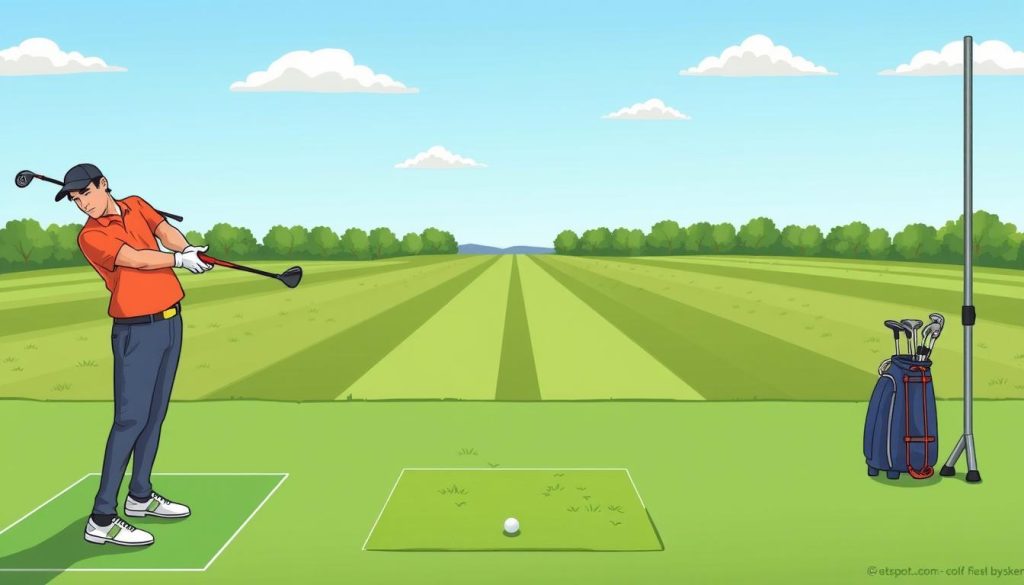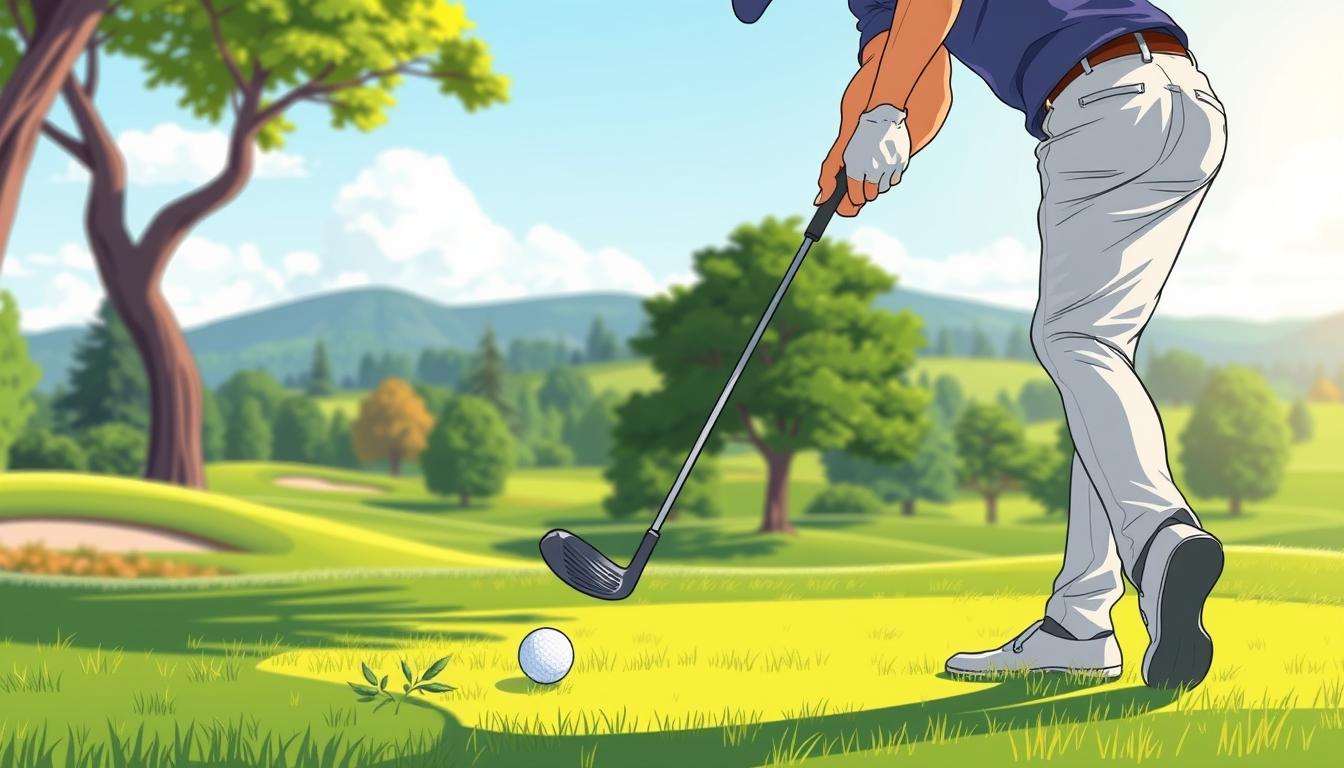Golf swing mechanics are key to your game. The release is a critical part of a good swing. This guide will help you master your golf swing release, boosting your game. Understanding the golf swing takeaway basics is essential as it sets the tone for a successful swing. A smooth and controlled takeaway will naturally flow into a well-timed release, ensuring maximum power and accuracy. By refining both aspects, you’ll develop a consistent and effective swing to elevate your performance on the course.
With nearly 30 years as a PGA Professional, I’ve seen how mastering the release changes a golfer’s game. It’s not about forcing your hands over. It’s about keeping the right wrist angle and letting your body rotate.
A proper release leads to a square clubface at impact. This means your ball will fly straighter and farther. This guide will walk you through the steps to a proper golf swing, focusing on the release.
For new golfers, building a strong foundation is crucial. We’ll cover posture, grip, alignment, ball position, and more. These basics are vital for good golf swing mechanics.
Key Takeaways
- The golf swing release is crucial for straight shots and increased distance
- Proper release involves maintaining wrist angle and body rotation
- A square clubface at impact is essential for optimal ball flight
- Building a strong foundation of golf swing fundamentals is important
- Understanding proper release techniques can significantly improve your game
Understanding the Golf Club Release Fundamentals
Golf swing release mechanics are key to hitting the ball far and straight. Many golfers think it’s about forcing their hands at impact. But, let’s explore what a proper release really means for your game.
What Happens During Club Release
The release happens when your clubface opens, squares up, and then closes past the ball. Your lead wrist goes from bent to straight after hitting the ball. Getting this right is vital for hitting the ball well and generating power.
The Role of Clubface Position
The position of your clubface at impact affects how the ball flies and spins. If you release too early, you lose power and accuracy. To do better, keep your hands in the right position during impact.
Impact Zone Dynamics
The impact zone is where the club hits the ball. It’s the most important part of your swing. Try a drill by placing a tee in front of the ball.
Practice swinging back until your lead arm is parallel to the ground. Then, swing through and stop with the clubhead pointing at the tee. The aim is to hit the ball with the right sequence for power. Regular practice will help improve your swing and how you deliver the club.
Essential Components of a Proper Golf Swing Release
A proper golf swing release is key for a square clubface at impact. It also helps with penetrating ball flight and more distance. To get better at this, focus on several important parts of your swing.
Start with a neutral grip and a stable base. Your weight should be evenly split between both feet. This is the base for a good release.
Keep a slight bend in your knees and a straight back for strong posture.
Wrist action is crucial in the release. At the top of your backswing, don’t overextend your lead wrist. As you hit the ball, your lead wrist should be flexed or flat.
After hitting the ball, your wrist moves from flexed to extended. This happens as your trail arm crosses over your lead arm.
Body rotation is also key. Proper extension and rotation through impact help with a better release. Turn your body towards the target, not just your hands.
- Maintain a downward strike for better contact
- Avoid slowing down or decelerating through impact
- Practice consistently to refine your release technique
Mastering the release takes time and effort. Get help from a professional instructor to fix any swing issues. Use drills like the Swing Plane Drill or Impact Bag Drill to improve your release timing and mechanics.
The Three Primary Release Methods in Golf
Golf release methods are key to your shot’s success. We’ll look at three main techniques: push release, crossover release, and slap hinge release. Each has its own benefits for different players.
Push Release Technique
The push release is best for skilled players with strong grips. It leads to a flatter ball flight and consistent results. This method is great for those who want reliable control over their shots.
Crossover Release Method
Skilled amateurs often choose the crossover release. It involves rotating the right hand and left forearm counterclockwise at impact. This suits players with neutral or weak grips, aiming for a draw. It’s ideal for those who value rhythm and tempo.
Slap Hinge Release Style
The slap hinge release is perfect for beginners and seniors. It uses wrist motion to increase speed, helping those with slower club head speed. Though simple, it’s less consistent due to timing.
| Release Method | Skill Level | Grip Type | Ball Flight |
|---|---|---|---|
| Push Release | Experienced | Stronger | Flatter |
| Crossover Release | Skilled Amateur | Neutral/Weak | Draw |
| Slap Hinge Release | Beginner/Senior | Any | Higher |
Knowing these golf release methods can help you pick the right one for your game. Remember, being consistent is crucial. Practice your chosen method to boost your performance on the course.
Mastering Your Setup Position for Optimal Release
Your golf setup position is key to a great release. A good setup helps you swing better, hit more accurately, and go farther. Let’s look at what makes a setup effective.
Grip Pressure and Hand Position
Begin with a neutral grip, holding the club with just the right amount of pressure. Don’t squeeze too hard, as it limits your swing. Your hands should work together, forming a strong bond with the club.
Body Alignment Fundamentals
Make sure your shoulders, hips, and feet are lined up with your target. If you want a draw, stand a bit to the right. For a fade, stand a bit to the left. This small change in alignment can greatly affect your shot.

Weight Distribution Guidelines
Start with your weight evenly split between both feet. This balanced stance keeps you stable as you swing. As you swing, your weight will shift, but starting balanced is crucial.
Your setup position affects your swing’s center. Use your arm pit as a guide. Place the ball just off your lead heel to hit straighter drives. Wrong ball positions can cause slices, hooks, or hitting the ball too low, affecting direction and distance.
Mastering these setup basics helps you swing better and release more powerfully. This leads to more consistent and strong shots.
Wrist Action and Release Mechanics
Wrist action is key in your golf swing release. Knowing how to use your wrists can really boost your game. Let’s explore how wrist movement impacts your swing.
During a golf swing, wrists move in three main ways: extension/flexion, radial deviation/ulnar deviation, and pronation/supination. Mastering these movements helps control the clubface and shoot straighter.
Pro golfers extend their wrists in the backswing and flex them at impact. This wrist change adds power and proper ball compression. The wrist hinge is vital for creating swing lag, boosting clubhead speed at impact.
To better your wrist action, try these drills:
- Ruler and glove drill
- Golf driver hold the finish drill
- HackMotion training
These exercises can improve your wrist angles and swing performance. Remember, bad wrist action can cause slices, hooks, and power loss.
| Wrist Movement | Effect on Swing | Common Mistakes |
|---|---|---|
| Flexion | Controls clubface at impact | Early release |
| Extension | Creates lag in backswing | Cupping at impact |
| Radial Deviation | Helps set wrist angle | Over-hinging |
By focusing on proper wrist flexion and extension, you’ll enhance your release mechanics. This will lead to more consistent results on the course.
Common Release Mistakes and How to Fix Them
Golf swing flaws can really hurt your game. It’s key to know and fix these problems to get better. Let’s look at some common mistakes and how to solve them.
Early Release Issues
Early release, or “casting,” is a big issue for many golfers. It happens when you release your wrists too early in the downswing. This can make your shots weaker and less accurate.
To fix this, keep your wrist angles right throughout your swing. Try half-swing drills to build muscle memory for the right release timing.
Late Release Problems
Late release can cause pushes or slices. It’s when you hold onto the wrist angle too long. To fix this, work on your swing tempo.
Try counting “1-2” during your backswing and “3” on your downswing. This rhythm helps time your release better.
Grip-Related Release Errors
Grip problems can lead to inconsistent releases. A grip that’s too weak or too strong can cause issues. Make sure your grip pressure is just right.
Check your hand position on the club. A neutral grip is usually best for most golfers.

Fixing these mistakes takes time and effort. Focus on one issue at a time to see improvement. If you’re really struggling, getting professional help can be a big help.
Advanced Release Techniques for Power Generation
Learning advanced release techniques is crucial for better golf swing lag and power. These methods help increase your clubhead speed and improve your game.
Lag Creation Methods
Golf swing lag is key for more power. Keep the angle between your lead arm and club shaft during the downswing. This builds energy for explosive shots at impact.
- Practice the ‘whoosh drill’ to feel proper lag
- Use a towel drill to improve wrist hinge
- Focus on keeping your hands ahead of the clubhead
Speed Generation Through Release
Proper sequencing is essential for speed through release. Start with hip rotation, then shoulder turn, and end with a push from your trail arm. This makes your swing powerful and fast.
| Release Stage | Body Part | Action |
|---|---|---|
| 1 | Right Hip | Initiate rotation |
| 2 | Right Shoulder | Continue rotation |
| 3 | Trail Arm | Push/thrust motion |
Every golfer’s swing is different. Try these techniques to see what works for you. With practice, you’ll get a powerful release that boosts your game.
Training Drills for Perfect Release Timing
Mastering your golf swing release is key to better performance. Let’s look at drills to improve your release timing and swing mechanics.
Half-Swing Practice Methods
Half-swing drills are great for timing your release. Start with 50-yard wedge shots on the range. This helps your body and arms sync up.
Top players like Scottie Scheffler use this drill to find their rhythm. Keep your hands and arms relaxed, like PGA Tour winner Jake Knapp.
Impact Position Drills
The acceleration drill helps perfect your impact position. Make a shorter backswing to avoid casting and ensure crisp contact.
This drill makes you keep proper positions as club speed goes up. Many golfers struggle to release the club at impact. Practice letting go and letting your right hand come off naturally for a stronger swing.
Follow-Through Exercises
The “halfway to halfway” drill helps you develop a smooth follow-through. It improves your technique in a shorter swing, leading to more distance with less effort.
Use alignment sticks or tees to guide your follow-through. This ensures proper wrist angles and body rotation. With regular practice, these drills will boost your release timing, impact position, and follow-through.
FAQ
What is the golf swing release?
Why is the release important in golf?
What are the key components of a proper release?
What are the three primary release methods in golf?
How does wrist action affect the golf swing release?
What are common release mistakes in golf?
How can I improve my golf swing release?
What is lag in the golf swing?
How does clubface position affect ball flight?
What are some effective drills for perfecting release timing?
Source Links
- https://www.golflink.com/instruction/proper-golf-swing
- https://golfinsideruk.com/how-to-swing-a-golf-club-a-different-way-of-thinking/
- https://www.golfmonthly.com/videos/long-game-tips/what-is-the-release-in-golf
- https://rotaryswing.com/c4/238-5-minutes-to-the-perfect-golf-club-release
- https://usawire.com/understanding-the-importance-of-the-golf-swing-release/
- https://hackmotion.com/how-to-release-golf-club/
- https://nationalgcla.com/the-basics-of-the-golf-swing/
- https://golf.com/instruction/10-fundamentals-needed-for-great-golf-swing/
- https://theleftrough.com/golf-swing-release/
- https://upglove.com/mastering-the-short-game-dan-grieve-3-releases/
- https://rotaryswing.com/golf-instruction/advancedgolftechnique/three-different-golf-releases-henry-cotton
- https://skillest.com/blog/mastering-the-follow-through-in-your-golf-swing/
- https://www.dannymaude.com/blog/You Can’t Hit Driver Straight Using This Popular Ball Position
- https://hackmotion.com/wrist-action-in-golf-swing/
- https://www.titleist.com/instruction/wrist-action-sequence?srsltid=AfmBOooXXLYqi4FxdByQZIVrdfezzZWZ4ShVOpKyLx36pBB8Q6VpyArc
- https://hackmotion.com/common-golf-swing-mistakes/
- https://collegeofgolf.keiseruniversity.edu/the-biggest-mistakes-you-are-making-with-your-golf-swing/
- https://www.vivanteegolf.com/blogs/golf-101/golf-swing-mistake-terms?srsltid=AfmBOoohcEzgCWl1ch2JRnhETlV0ZaD7pYw7iKt1-j6ViwzlShDvOvIg
- https://patch.com/pennsylvania/doylestown/release-sequence-unlocking-power-accuracy-your-swing
- https://rotaryswing.com/c4/112390-overview-of-the-push-release
- https://rotaryswing.com/golf-instruction/golfbiomechanics/5-minutes-to-the-perfect-release
- https://www.golfmonthly.com/videos/golf-swing-tips/4-timing-drills-for-golf


